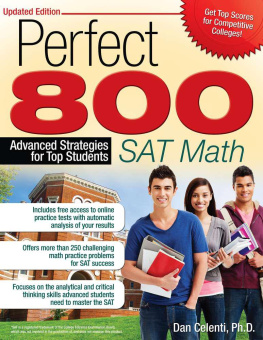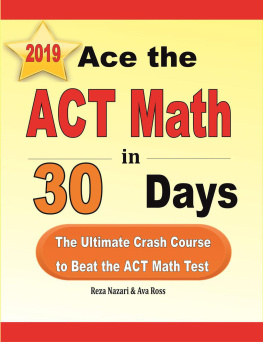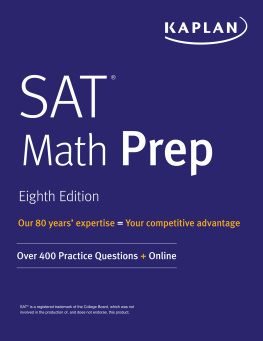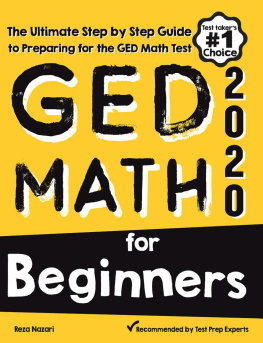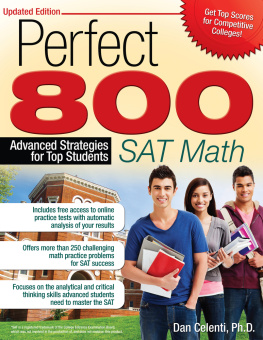

Dan Celenti, Ph.D.

Prufrock Press Inc.
Waco, Texas
Copyright 2014 Prufrock Press Inc.
Edited by Lacy Compton
ISBN-13: 978-1-61821-208-5
No part of this book may be reproduced, translated, stored in a retrieval system, or transmitted, in any form or by any means, electronic, mechanical, photocopying, microfilming, recording, or otherwise, without written permission from the publisher.
At the time of this books publication, all facts and figures cited are the most current available. All telephone numbers, addresses, and website URLs are accurate and active. All publications, organizations, websites, and other resources exist as described in the book, and all have been verified. The author and Prufrock Press Inc. make no warranty or guarantee concerning the information and materials given out by organizations or content found at websites, and we are not responsible for any changes that occur after this books publication. If you find an error, please contact Prufrock Press Inc.
 | Prufrock Press Inc.
P O. Box 8813
Waco, TX 76714-8813
Phone: (800) 998-2208
Fax: (800) 240-0333
http://www.prufrock.com |
The value of an education is not the learning of many facts but the training of the mind to think.
Albert Einstein
Contents
Acknowledgements
To the students I had the privilege to work with over the years, I am extremely grateful. I want to thank them for putting up with my occasionally unconventional methods of teaching math, providing me with candid and useful feedback, andmost of allfor making my interaction with them translate into hours of fun and rewarding work.
In addition, I want to thank my children for fueling my passion for smart education; Dr. MAC (Jean DArcy Maculaitis, Ph.D., President and founder of MAC Testing & Consulting, LLC) for being the catalyst for my involvement in various aspects of SAT preparation andthrough her work and dedication of many yearsproviding me with a continuous source of inspiration; and my wife for her relentless support and encouragement.
Foreword to the Updated Edition
Given the tremendous number of SAT books on the market, the reception received by the first edition of this book far exceeded my expectations. The fact that so many parents and students embraced the idea that math should not be a continuous exercise in memorization and applying trial-end-error using a calculator but rather a quest to improve ones analytic/critical thinking skills was extremely encouraging and certainly played a major role in the decision to follow the first book with an updated edition.
The major changes to the original edition are additions in two areas: number of SAT problems (and solutions) and mind games.
Included in .
Minor modifications, corrections, and additions were also made tohopefullymake the possession of this book a more rewarding and fulfilling experience.
In its new format, the book includes 200 SAT problems to be complemented by 54 and 38 additional problems used in the SAT and PSAT online tests (see ), respectively.
As always, I would like to encourage and look forward to your comments, questions, and suggestions.
Dan Celenti
http://www.challengemath.net
June 2013
Introduction: Why Another SAT Book?
The real voyage of discovery consists not in seeking new landscapes but in having new eyes.
Marcel Proust
The vast majority of SAT-prep books are structured as one-size-fits-all products. As a result, (a) less-than-average and average students find themselves emerged into a system that does not provide them with an easy strategy to improve (i.e., identify and work on their weaknesses) and (b) advanced students would find a significant percentage of the covered topics to be too easy and thus of insignificantif anyvalue to them.
This book is designed to primarily address the needs of gifted and advanced students (i.e., students expected to score above 600 on the math section of the SAT, as shown in problems. In addition, it offers an approach to studying that emphasizes the importance of logical thinking and the idea of reasoning as paramount to problem solving.
).

This books methodology not only will ensure that every topic is well-suited for its audience of gifted and advanced students but also, by emphasizing critical thinking/analytic skills, will result in a much more optimal usage of your time and maximize the pace of progress in preparing for the test.
This Books Approach
The world we have created today has problems which cannot be solved by thinking the way we thought when we created them.
Albert Einstein
Scattered throughout the book are 200 problems solved as test cases. They were selected for (a) being representative for an entire category of problems that historically were given in real tests and (b) their suitability for showcasing the importance of logic and analytic skills over memorization.
Every time an example is given, students are strongly encouraged to take a few minutes not only to familiarize themselves with the problem but also to try to solve it. Only after that should you go over the solution suggested by the author. Note that almost without exception, SAT problems have unique solutions obtained through a variety of methods. Selecting and/or suggesting the quickest or the smartest method is a very subjective endeavor. It depends on a variety of personal traits and skill sets including, but not limited to, the prevalent memory type (visual or abstract), whether you are naturally inclined to rely more on logic or sheer memorization of factual knowledge or formulas, familiarity with algebraic techniques, knowledge breadth, and so forth. As a result, it is not my intention to suggest that my way of solving a problem is either (a) the only way or (b) the best way. It is, however, my intention to use my approach as a brainstorming exercise that would eventually act as a catalyst in helping you develop your own problem-solving approach and methodology.
This book includes an online test package (see http://www.prufrock.com/perfect800) with a simulated test that, once completed by you, will generate an in-depth analysis of your results and a list of recommendations for an improved performance.
My philosophy and approach are eloquently summarized in the words of Albert Einstein: Any fool can know. The point is to understand.
In a typical PSAT, approximately of problems are rated easy, medium, and hard. This also is valid in the SAT test, where problems are ranked on a scale from 1 to 5 with 5 being the most difficult.
The rare exceptions I found are problems for which two numerical solutions are equally valid.
Part 1: General Test-Taking Advice and Strategies
Chapter 1
What Is Math and Why Do I Need to Study It?
Maththe language nature uses to describe her wonders Math is natures playbook, a tool for discoveringand not merely describingnatures laws.
Next page
